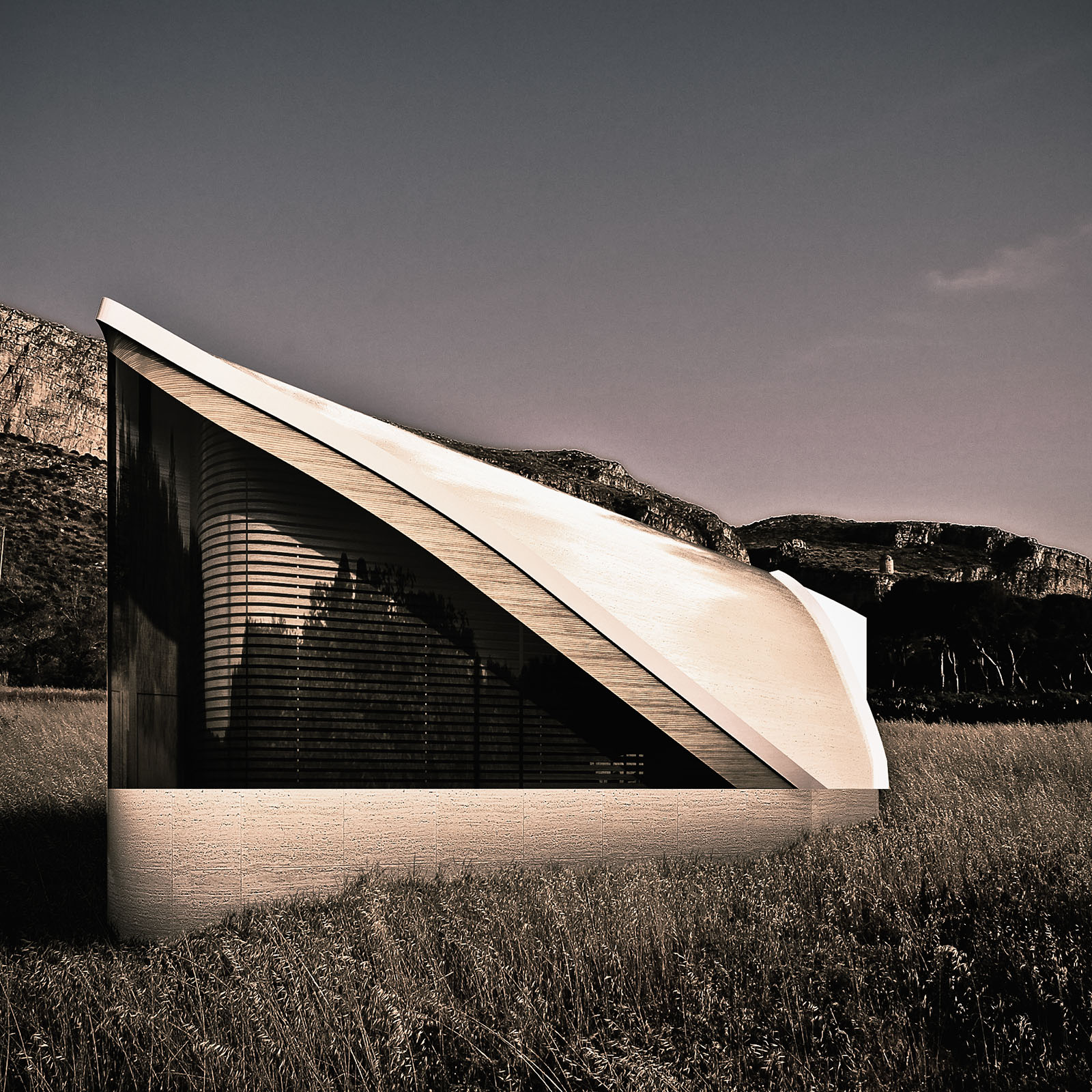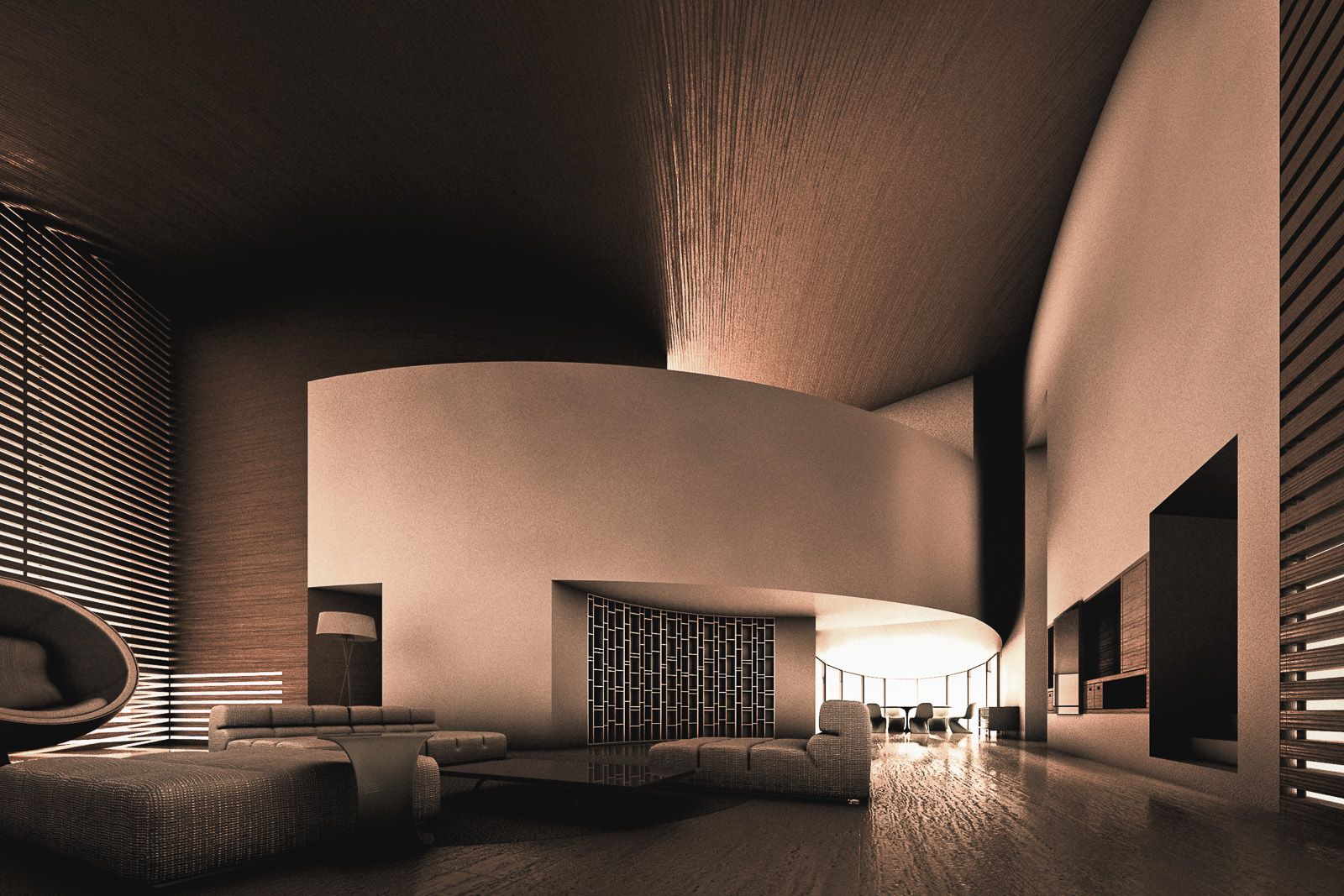Data
- Time: Design (Mar – Jul 2008)
- Place: Barcelona, Spain
- Area: 360 m² (two storeys)
- Typology: Detached house
Barcelona,
The third instalment in the Houses for No One collection, this structure embarks on a voyage into the realm of transition and movement. It engages with light to manipulate perception, proposing an exploration of the changing colours of the celestial hemisphere
Antonino Cardillo
Architecture and music have met over the centuries […] to converse secretly in search of their common roots and fruitful interactions. Perhaps the most fruitful interaction can be found in certain dance figures, where the coordinated movement of bodies generates ephemeral architectural forms of supreme beauty.
— Paolo Portoghesi, Musica e Architettura (1970)
If architecture is music in stone can its ‘limbs’ dance? Architecture only remains still in pictures. In real life its natural state is one of transition. Both man and light move within it.
Inside a house among coarse Mediterranean glades and corrugated stone walls, a slanting light, pierced by innumerable narrow repeated blades, inscribes and describes the walls with its impermanent, mutable hand. How many possible stories will this light tell over the course of a year?
A curved wall jokes with the light. The light bathes the wall, but reaches the moment and the place in which, going beyond the curve, it takes a tangent, deciding what will be lit and what will be dark. And this movement suggests the indefinite, mutability, shading.
Thus architecture becomes light interpreted through the ‘limbs’ of the architecture. Like shadows of flesh on flesh, whose forms are both definite and defining. Here, as in a Flamenco dance, the body breaks up, invading the space moving through its potential articulations without, however, defining the void, or, interpreting the many possibilities of moving within it: fleshy and sensual, but equally incisive and precise. Secret but luminous. Closed but open to a multitude of possibilities. A body inside another body. Compressed and continuous in its curvilinear trajectory.
And yet, as in a Flamenco dance, the development of movement, its indefinable ardour, is made real by the successive instant. That solemn, still instant that seems to challenge eternity. Thus, tall and still, a wall opposes silence. And such stillness supports the preceding movement, giving sense to its being.
worldarchitecturenews.com, London, 10 June 2008.
Antonino Cardillo







2019 – 2007
Kirsten Wenzel
Apart from the involuntary irony that Der Spiegel appears in both impostor stories, once as a prosecutor and once as an accused, they differ fundamentally.
competitionline.com, Berlin, 17 January 2019 (de, en, it)
Jeanette Kunsmann with Stephan Burkoff
Cardillo has created a labyrinth of truths and illusions. It is a novella with multiple layers. […] There is no one truth—reality: it doesn’t exist. Antonino Cardillo has built it.
DEAR Magazin, no. 1, Berlin, April 2017, p. 84 (de, en, it)
Carolin Höfler
After the representations were revealed as desired pictures, he replied: ‘Just see it like a literary narrative, […] a fairy tale. It is also not important that things actually happened’.
Konstruierte Realitäten, Goethe‑Universität, Deutsche Architekturmuseum, Frankfurt am Main, 1 December 2015 (de, en, it)
Yoeri Khyrian Jonker
The work of architect Antonino Cardillo has always seemed very cinematographic: his 2008 project [House of] Convexities for instance feels like a modern interpretation of David Lynch’s Dune.
thelavishworld.com, Antwerpen, 11 December 2013 (en)
Gérard Houllard
In fact, Cardillo is right here at its core, because as this essay also wanted to show, images of unrealised and utopian architectures can become an integral part of architectural history and not insignificantly influence it.
IACSA Newsletter, vol. 4, no. 1, Basel, May 2013, p. 11 (de, en, it)
Carl Zillich
Cardillo, who meticulously lists all these press reports on his website, only holds up a mirror to architectural media and points out a fundamental problem: how can young architects find clients without having been published?
bkult.de, Berlin, 10 September 2012 (de, en, it)
Christian Holl
How do we construct our reality from the material and the imaginary through the media today and what are the consequences? […] If the case of Cardillo now serves to at least seriously discuss one of these questions again, he may have done more for the architectural discourse than those who think they have always known the answer.
german-architects.com, Stuttgart, 29 July 2012 (de, en, it)
Gabriele Detterer
Incidentally, architecture has always been ephemeral and virtual, he explains. From Palladio to Schinkel, from Sant’Elia to Mies van der Rohe, architects influenced architectural development and changed reality with ideas in the form of surrogates.
Neue Zürcher Zeitung, no. 164, Zurich, 17 July 2012, p. 40 (de, en, it)
Susanne Beyer
When Felix Krull was young, he pondered for a long time whether he should view the world as small or large. According to his ‘nature’, he later in life ‘considered the world to be a great and infinitely alluring phenomenon’. He became the happiest impostor in literary history.
Der Spiegel, no. 27/12, Hamburg, 2 July 2012, p. 121 (de, en, it)
Peter Reischer
An email inquiry pointing out that the architectural photos depicted or submitted are not photos but renderings, receives the terse response: ‘I am an artist and as an artist I manipulate reality! That’s it!’
Falter, no. 19/12, Vienna, 9 May 2012, p. 31 (de, en, it)
Judith Jenner
Traditional Andalusian Flamenco has inspired many artists: Federico García Lorca with his poetry, Pablo Picasso with his paintings and sculptures, and the young Italian architect Antonino Cardillo with a house.
H.O.M.E., no. 2/10, Berlin, February 2010, p. 126 (de, en, it)
Ridhi Kale
True to its inspiration, the house has elegant twists and turns that create an impression of perpetual motion. The light inside keeps changing as the shifting sun filters in through the window’s blades. And each inner space, be it the curve of the walls, the arc of the roof, or the straight lines of the windows, comes alive when the light streams in.
Home, India Today, Mumbai, January 2010, p. 47 (en, it)
Thomson Carpenter
The first to admit to being a dreamer, Cardillo concedes to inhabiting a virtual world, a parallel universe, moreover describing his fall into architecture as a chance happening.
DNA, no. 119, Sydney, December 2009, p. 105 (en, it)
Rohan Yung
According to the Almanac of Architecture & Design, these are some of the world’s top new architectural wonders.
Going Places, Malaysia Airlines, Kuala Lumpur, May 2009, pp. 44‑45 (en, it)
Ramia Habchy
The play of light within the convex walls of this house create a romantic aura that envelopes visitors and transports them into a world of wonder at the inspired superiority that made this beautifully shaped structure possible.
Touch Decor, Beirut, October 2008, p. 58 (en, it)
Matt Hussey
We’d all like a bit more space around the house. We’re not talking Changing Rooms-style wall hangings and naff trompe l’oeil—we mean golf club-swinging, echo-inducing caverns that make you wish you’d mastered acrobatic gymnastics whenever you walk into them.
ShortList, no. 52, London, October 2008, p. 6 (en, it)
Devyani Jayakar
In the theatrically sculpted volumes of high vaulted roofs and large spaces which dwarf the viewer, the voluptuous curves in the asymmetrical layout, and the slow, mutable chiaroscuro of light and shadow which marks the passing of time, is perhaps where Antonino’s signature lies. At least for the present.
Inside Outside, no. 280, Mumbai, October 2008, p. 119 (en, it)
2015 – 2009
Goethe-Universität, Deutschen Architekturmuseum, Frankfurt am Main,
At the invitation of Professors Chris Dähne, Frederike Lausch and Bettina Rudhof, Cardillo presented the Seven Houses for No One series and spoke about the faked reality in the conference ‘The Dream Houses of Antonino Cardillo’, part of the Constructed Realities series of Goethe University at the German Museum of Architecture in Frankfurt.
Schweizerisches Architekturmuseum, Basel, –
Curator Hubertus Adam exhibited some publications on the House of Convexities and mentions the ‘Cardillo phenomenon’ in the Building Images. Photographie Focusing on Swiss Architecture exhibition at the Swiss Museum of Architecture in Basel.
The Horse Hospital, London, –
At the invitation of musician John Foxx, a print of Ellipse 1501 House and the video Tales of Light—featuring four projects later included in the Houses for No One series—were exhibited as part of a show dedicated to artists he inspired, held at The Horse Hospital in London.
2024 – 2008 (selected)